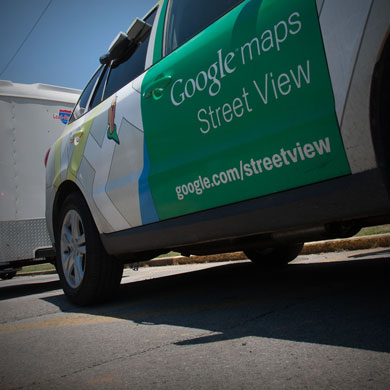Let’s face it, we High Ed Web folks get to do a lot of pretty cool stuff in effort to find the most innovative ways to set our institutions apart from the fray. We are challenged to implement cool new strategies and we try to do it in affordable, user-friendly ways that will benefit our colleges and universities.
As part of a 2011 web redesign effort, Western Kentucky University launched a virtual tour of campus aimed at prospective students. To enhance the tour, WKU joined the Google Street View Partner Program in June to give prospective students and alumni a closer look at campus growth. The project itself took a few weeks of prep before the Street View crew arrived on campus and we anticipate our results will be active on Google Maps sometime later this year. It was a fun experience and I learned some things along the way that I hope might help some of you should you choose to join the program.

What is the Google Street View Partner Program?
Google has enhanced their 360-degree image collection technology to offer so much more than the Google Street View that most of us have seen when using Google Maps or Google Earth. In the past, images were collected via camera-mounted vehicles that obtained footage from the street. By mounting special camera equipment atop a tricked-out, grown-up tricycle, they’re able to shoot 360-degree images from the lesser-traveled sidewalks of your campus. The most beautiful part about it, for you, is that it’s completely free.
“We are super excited to be able to expand the comprehensiveness of Street View imagery collection to build that perfect map,” said Google spokesperson Deanna Yick. “We realized that there are places around the world where cars can’t go and fit — including university campuses. So we’ve taken the same camera technology and placed it on trikes that enable us to navigate through tighter spaces. Ultimately, we hope to enable users to virtually explore and enjoy these properties wherever they may be in the world.”

Preparing for Google
We were assigned a project manager (our “Google Guy”) who coordinated the Street View ground crews from Google HQ in California. We worked closely for a few weeks ahead of time to plan what locations they would shoot, when they would shoot and we had to work out access to facilities between on campus summer camp activities, make alternate inclement weather plans, parking arrangements for their trailer and more.
The crew arrived several days before our shoot was scheduled, and their souped-up Hyundai created quite a buzz across our local community. I connected with Google’s Global Communications Department ahead of time to obtain permission to take photos and video footage of their visit for local media and promotional materials on our website.
HINT: Allow lots of time to arrange this, as they like to approve photos and video footage in advance of publication. The Street View ground crew members are contracted employees and may not be interviewed on camera or quoted in any way. In addition, some of their proprietary equipment may not be photographed. But in the Facebook era, when you have a guy on a crazy-looking bike riding all over your campus, folks are going to stare — and take photos that will then be posted all over the Web in real time.

Day One: Interiors
We began by mapping the interior of WKU’s E.A. Diddle Arena. We provided campus maps and interior evacuation maps of our basketball arena so that footage could be obtained indoors using a combination of collected imagery and Google 3D SketchUp technology.
HINT: Bring back up that knows something about the ins and outs of your interior space. The crew will want a detailed full-interior tour. It is also impossible to arrange interior mapping on the fly. The logistics have to be worked out in advance several days before the crew comes to your campus.
The crew brought a large battery-powered camera-mounted trolley into the arena to shoot. The interior mapping was a slow process that took several hours. Walk five feet, stop, photo. Walk five feet, stop, photo. Though slow, this allows the coolest camera ever to shoot 360-degree views of your interior space. The two-man crew shot our full basketball floor and all seating levels of the interior of the arena and then they walked the loop around the perimeter of the inside, collecting imagery of ticket offices, concessions, auxiliary gyms, etc. Once the footage goes live, visitors will be able to get a seat-view feel for our arena. Very cool!
Day Two: What golf cart?
Day two brought a second, separate two-man Street View crew to our campus that greeted me with two questions: 1) “Where’s our map?” (the one that I’d emailed and they had not brought with them) and 2) “Where’s your golf cart?” Both items would have been helpful had my Google Guy actually prepped me for that. (All they asked for were parking passes)
HINT: Bring extra maps and a golf cart.
Luckily, I was able to locate a golf cart and chauffeur for the day. For about four hours, we lead the way in the cart and the trike followed. HINT: It’s better if the Street View crew can visit your campus when it’s empty – no people obstructing your buildings and no faces to blur out later. Also, if you have construction on your campus they will come back at a later date and re-shoot those areas. The crew will not drive through or ride in an active construction site.
I worked out a schedule that allowed the crew into our outdoor athletic facilities and we had to navigate the challenge of WKU’s “Hill.” Our main campus is located atop the highest elevation in South Central Kentucky, so as you can imagine, this posed a challenge for a guy rocking a 400 lb. camera-adorned trike in 98-degree weather. We managed it so that most of our trek was downhill and I’m proud to say we only got stuck once.
At various points in a year, Google has dozens of Street View crews on the ground all over the country. Our crew started in San Francisco weeks before and arrived in Bowling Green after a stint in New Orleans , and they were heading down to Nashville when they finished with us. And I thought I had a cool job!

Day Three: Clean up, clean up, everybody everywhere
On Day Three I didn’t have the luxury of a golf cart, so I walked beside the trike underneath the camera so that I wouldn’t be featured in the footage. We collected imagery of our outdoor athletic facilities including our football arena.
HINT: Arrange for your school’s mascot to be hanging out in the stands of your football stadium when the crew rides through to offer your fans an extra thrill when they view your footage online.
Once we finished with the trike, it was up to the crew to finish off the perimeter of campus with the car. The camera-mounted car is equipped with lots of GPS and computer equipment. It is used to collect street view footage on any available street on your campus. This part only requires a map to show your crew where to go, so regrettably, you won’t get to ride in the car, or on the trike.
Overall, it was a great experience. Our footage will take several months to clean up and render and we are looking forward to repeat campus visits to take additional footage of completed construction sites in the future.

A Note about Privacy
Campus and student security and privacy concerns are always at the forefront of anything we do in higher education. At WKU, we discussed these concerns in great detail before we agreed to participate in the program involving our general counsel and administration. The Google imagery that is displayed online is not real-time imagery. Any faces, license plates, etc., that are captured are blurred out by Google’s automatic blurring technology before the images go live and institutions are given advance approval before they launch. If at any time your institution wants images removed or further obscured, a “Report a Problem” tool is available on every Street View page to handle those requests promptly as well.
“We take privacy very seriously,” said Yick. “We work very closely with every university and college in the Partner Program to coordinate exactly which areas we will collect to be sure we are capturing imagery that you want to be online and that you feel will be helpful and useful to for students and alumni while respecting your wishes if there are areas that are off limits.”
At WKU, we opted to have Google come to campus in the summer when campus was practically empty and the only interior footage we have allowed Google Street View to obtain so far is of a community-wide public space – our empty basketball arena. As a rule, Google Interior Mapping (which is a separate division from Google Street View) does not shoot interiors of residence halls and we have opted against collecting interior imagery or virtual floor plans of academic buildings as well.

How to apply
View examples of campuses with live footage and to apply to become a part of the program.
Additional links about the WKU experience:
All photos by Clinton Lewis.

